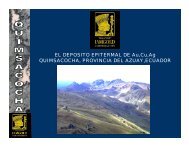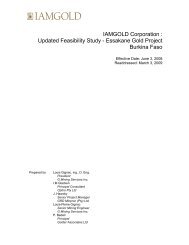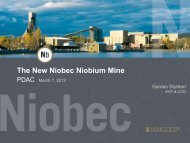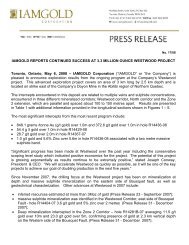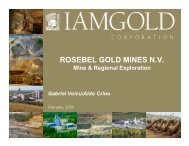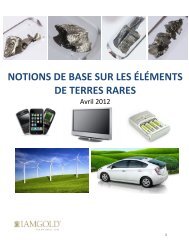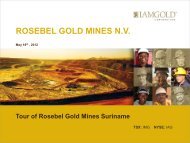NI 43-101 Technical report, Surface diamond drilling ... - Iamgold
NI 43-101 Technical report, Surface diamond drilling ... - Iamgold
NI 43-101 Technical report, Surface diamond drilling ... - Iamgold
Create successful ePaper yourself
Turn your PDF publications into a flip-book with our unique Google optimized e-Paper software.
R a r e E a r t h E l e m e n t E x p l o r a t i o n P r o g r a m M a r c h - 2 0 1 3<br />
W i n t e r - S u m m e r 2 0 1 2 P a g e | 17<br />
This carbonatite is known as the host of two individual deposits:<br />
• Niobium deposit in the south part of the carbonatite, which constitute the principal<br />
Niobec mine;<br />
• REE Zone mineralized in lanthanides elements, located in the central part of the<br />
carbonatite.<br />
9.2.1 The St-Honoré alkaline complex<br />
9.2.1.1 Geological Highlights<br />
The first complete geological map, using the different geophysical surveys and drill holes<br />
data realized between 1967 and 1975, has been produced by Soquem geologists (Gauthier.A<br />
and al.) in 1978. This map, based on petrographic and geochemical studies which allow the<br />
definition of the different carbonatite terms (Fortin, 1977), has been actualized and<br />
reinterpreted in 1986 by Niobec Mine geology staff using the additional drill holes data<br />
realized by Soquem in 1985.<br />
The geological compilation map of Figure 5 is the result of a synthesis of these entire maps<br />
and the drill holes data since 1967.<br />
The Alkaline complex is composed by a central carbonatite core, surrounded by mainly an<br />
alkaline syenite, a feldspathoid bearing syenite and syenitic foidites (Ijolites and urtites)<br />
(Fortin, 1977; Figure 5). The contact of this complex with the country rocks is marked by a<br />
phlogopite calcitite in the northern part and in the southern part by the presence of a<br />
cancrinite bearing syenite (Dénommé, 1986).<br />
A chronology has been established for this Alkaline complex as follow from older to younger<br />
(Fortin, 1977):<br />
Ijolite - Urtite - Foidites syenite – Feldspathoid syenite – Alkaline syenite – Lamprophyre -<br />
Carbonatite<br />
Following a petrographic and geochemical study (Fortin, 1977) of different drill holes cores<br />
realized in the carbonatite by Soquem (Gagnon and al., 1973), different carbonatite units with<br />
different geochemical characteristics have been established. Four Sovites (Calcitites) types<br />
and three Rauhaugites (dolomitites) types have been recognized and constitute the different<br />
units of the carbonatite core. These units consist of a series of crescent shape lenses of<br />
carbonatite with younger compositions progressively inwards from calcitite through<br />
dolomitite to ferro-carbonatite (Fortin, 1997). This evolution is attested by the numerous<br />
xenolithes of the alkali syenite rocks in the carbonate at the scale complex and at a smaller<br />
scale between the different carbonates facies themselves.<br />
3400, chemin du Columbium, St-Honoré-de-Chicoutimi, QC G0V 1L0 Canada – tel. : 418 673-4694 Fax : 418 673-3179<br />
E-mail : info.niobec@iamgold.com www.niobec.com



